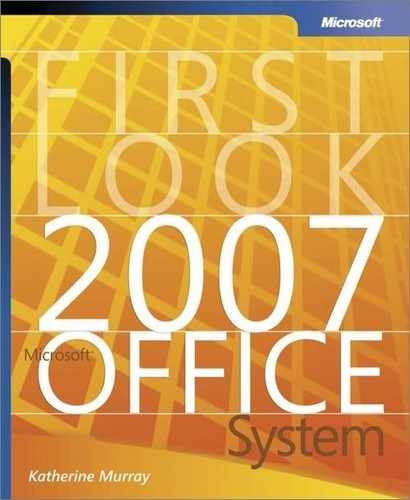The 2007 Microsoft Office System—Tools for Today
As you will learn throughout this book, the exciting changes in the 2007 release were designed to meet the very real challenges in the lives of real people. From school to home to office, we need fast, efficient, and simple ways to work with hectic schedules, manage information, run businesses, and manage global operations. That’s no small task!
The Microsoft Office system development team has been listening and learning from users for years, conducting detailed studies, hosting focus groups, and compiling data from the Office 2003 Customer Experience Improvement Program. The extensive amount of study and feedback is paying off in the 2007 Microsoft Office system—a radical change in a powerful suite of applications that not only provides the tools you need to accomplish important business tasks but also grows with you as a business analysis and development tool.
Tip
|
| For a fascinating look at the early stages of 2007 Microsoft Office system design and implementation (as told to Channel 9 by Office Program Manager Julie Larson-Green), go to channel9.msdn.com/Showpost.aspx?postid=114720. |
The 2007 Microsoft Office system was designed specifically with the following goals in mind:
Make the product easier to use. The dramatic and smart redesign of the look and feel of the Microsoft Office system does away with the overabundance of toolbars and the layers of nested dialog boxes. As you learn in Chapter 2, the design of the majority of the applications (Office Word 2007, Office Excel 2007, Office PowerPoint 2007, and Office Access 2007) now brings to you the tools you need to complete the task you’re working on. It’s easy to discover new features you didn’t see before because of the contextual display, but you don’t have to go searching through multiple levels of menus to uncover that one command you vaguely remember but can’t find.
Help you become more efficient. The redesign of the look and feel saves you time by making the options you need easier to find; the flexibility in the way you can work with the Microsoft Office system (choosing primary mouse-based or keyboard-based techniques) enables you to choose the work style you like best. Faster search capabilities help you locate what you need more quickly than ever; increased integration among the applications makes it faster and easier to share data and objects between programs.
Make it easier to find what you need. Super ToolTips help you understand how to use a feature and provide a link for more detailed help; Live Preview enables you to try an option (such as a style, font, or color) before selecting it. Galleries display a range of choices you can select quickly without digging through multilayered menus.
Make it easier to create great professional quality documents. A large collection of professionally designed templates is now part of all the core Microsoft Office system applications. Additionally, process-related help (such as Publisher Tasks, the Design Checker, the Document Inspector, and more) help you ensure that your documents and projects are as accurate and professional as possible before you share them with others.
BI and ECM in the 2007 Microsoft Office SystemIt’s easy to get caught up in the dramatic new look and feel of the new Microsoft Office system and overlook some of the more powerful behind-the-scenes features that don’t get the same level of press. But the 2007 release of the Microsoft Office system moves the suite out of the realm of “power software tools” you can use to accomplish specific tasks and into the category of a powerful suite of applications that strategically help you grow your business. Two dynamics that are key to the business development capabilities of the Microsoft Office system are features that support Business Intelligence (BI) and Enterprise Content Management (ECM). BI is the process of evaluating, reflecting on, and assessing the business environment in which a company operates. To collect the BI that a travel agency needs, for example, the owner or manager might do considerable marketing and industry research and then analyze all the competition to see how those companies are distinguishing themselves. The information gathered through BI helps business leaders plot out the appropriate course to achieve the company goals. BI helps companies answer these questions, among others: How well are we doing? Did that marketing campaign hit the mark? Are we in sync with the demands of our marketplace? How do we stand out from the crowd? ECM is really about managing the content of an enterprise. What does your company do with the content you produce? These content pieces might include digital content such as text, video, audio, or photos; transactions; catalogs; data; code. Planning the way you create, manage, publish, share, present, and store content is the function of an ECM system. New features built into the core applications—Office Word 2007, Office Publisher 2007, Office Excel 2007, and more—help you get better results from your efforts and plan long-term for the protection and dissemination of the content you produce with the 2007 Microsoft Office system. |
